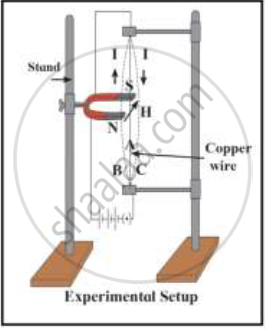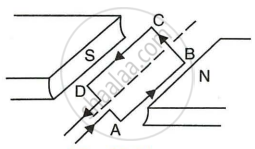Advertisements
Advertisements
प्रश्न
i) Which principle is explained in this figure?
ii) Which rule is used to find out the direction of a force in this principle?
iii) In which machine this principle is used? Draw a diagram showing working of that machine

उत्तर
i. A force is exerted on the current-carrying conductor in the presence of a magnetic field.
ii. The Fleming’s Left-hand Rule is used.
iii. Electric Motor
APPEARS IN
संबंधित प्रश्न
Consider a circular loop of wire lying in the plane of the table. Let the current pass through the loop clockwise. Apply the right-hand rule to find out the direction of the magnetic field inside and outside the loop.
Which of the following correctly describes the magnetic field near a long straight wire?
State whether the following statement is true or false
The field at the centre of a long circular coil carrying current will be parallel straight lines.
Imagine that you are sitting in a chamber with your back to one wall. An electron beam, moving horizontally from back wall towards the front wall, is deflected by a strong magnetic field to your right side. What is the direction of magnetic field?
State Fleming's left hand rule.
Name the rule for finding the direction of magnetic field produced by a straight current-carrying conductor.
State whether the following statement is true or false:
The magnetic field inside a long circular coil carrying current well be parallel straight lines.
What is the shape of a current-carrying conductor whose magnetic field pattern resembles that of a bar magnet?
Fill in the following blank with suitable words:
For a current-carrying solenoid, the magnetic field is like that of a ...........
What are the various ways in which the strength of magnetic field produced by a current-carrying circular coil can be increased?
What is the shape of field lines inside a current-carrying solenoid? What does the pattern of field lines inside a current-carrying solenoid indicate?
A soft iron bar is inserted inside a current-carrying solenoid. The magnetic field inside the solenoid:
(a) will decrease
(b) will increase
(c) will become zero
(d) will remain the same
For Fleming's left-hand rule, write down the three things that are 90° to each other, and next to each one write down the finger or thumb that represents it.
A current-carrying conductor is placed perpendicularly in a magnetic field. Name the rule which can be used to find the direction of force acting on the conductor.
The force exerted on a current-carrying wire placed in a magnetic field is zero when the angle between the wire and the direction of magnetic field is:
45°
60°
90°
180°
A current flows in a wire running between the S and N poles of a magnet lying horizontally as shown in Figure below:
The force on the wire due to the magnet is directed:

fron N to S
from S to N
vertically downwards
vertically upwards
force experienced by a current-carrying straight conductor placed in a magnetic field which is perpendicular to it.
Two coils A and B of insulated wire are kept close to each other. Coil A is connected to a galvanometer while coil B is connected to a battery through a key. What would happen if:
a current is passed through coil B by plugging the key?
Explain your answer mentioning the name of the phenomenon involved.
State condition when magnitude of force on a current carrying conductor placed in a magnetic field is zero?
Name and state the law which is used to determine the direction of force on a current carrying conductor placed in a magnetic field.
State the unit of magnetic field in terms of the force experienced by a current carrying conductor placed in a magnetic field
A coil ABCD mounted on an axle is placed between the poles N and S of a permanent magnet as shown in Figure.

- In which direction will the coil begin to rotate when current is passed through the coil in direction ABCD by connecting a battery at the ends A and D of the coil?
- Why is a commutator necessary for continuous rotation of the coil?
- Complete the diagram with commutator, etc. for the flow of current in the coil?
Name the following diagram and explain the concept behind it.

State two ways to increase the speed of rotation of a D.C. motor.
Differentiate between Conductors and insulators.
The following diagram shows two parallel straight conductors carrying the same current. Copy the diagram and draw the pattern of the magnetic field lines around them showing their directions. What is the magnitude of the magnetic field at a point 'X' which is equidistant from the conductors? Give justification for your answer.

State whether a magnetic field is associated or not around a static charge.
The north pole of Earth’s magnet is in the ____________.
The strength of magnetic field around a current-carrying conductor is ____________.
When current is parallel to a magnetic field, then force experience by the current-carrying conductor placed in a uniform magnetic field is ____________.
Which of the following factors affect the strength of force experience by current-carrying conduct in a uniform magnetic field?
A magnetic field directed in north direction acts on an electron moving in east direction. The magnetic force on the electron will act ____________.
What do you know about Michael Faraday?
A current-carrying conductor of a certain length, kept perpendicular to the magnetic field experiences a force F. What will be the force if the current is increased four times, the length is halved and the magnetic field is tripled?
Observe the given figure of Fleming's Left Hand Rule and write the labels of 'A' and 'B':

A copper conductor is placed over two stretched copper wires whose ends ate connected to a D.C. supply as shown in the diagram.
- What should be the magnetic poles at the points A and B lying on either side of the conductor to experience the force in the upward direction?
- Name the law used to find these polarities.

